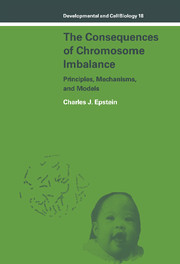Book contents
- Frontmatter
- Contents
- Preface
- Glossary
- PART I INTRODUCTION
- PART II CLINICAL OBSERVATIONS
- PART III THE THEORETICAL MECHANISMS AND ISSUES: THE PRIMARY AND SECONDARY EFFECTS OF ANEUPLOIDY
- PART IV EXPERIMENTAL SYSTEMS FOR THE STUDY OF MAMMALIAN AND HUMAN ANEUPLOIDY
- PART V THREE MAJOR CLINICAL PROBLEMS OF HUMAN ANEUPLOIDY
- 12 Trisomy 21 (Down syndrome)
- 13 Monosomy X (Turner syndrome, gonadal dysgenesis)
- 14 Cancer
- PART VI CONCLUSION
- Appendix: Standard karyotypes of man and mouse and human cytogenetic nomenclature
- References
- Index
13 - Monosomy X (Turner syndrome, gonadal dysgenesis)
Published online by Cambridge University Press: 14 October 2009
- Frontmatter
- Contents
- Preface
- Glossary
- PART I INTRODUCTION
- PART II CLINICAL OBSERVATIONS
- PART III THE THEORETICAL MECHANISMS AND ISSUES: THE PRIMARY AND SECONDARY EFFECTS OF ANEUPLOIDY
- PART IV EXPERIMENTAL SYSTEMS FOR THE STUDY OF MAMMALIAN AND HUMAN ANEUPLOIDY
- PART V THREE MAJOR CLINICAL PROBLEMS OF HUMAN ANEUPLOIDY
- 12 Trisomy 21 (Down syndrome)
- 13 Monosomy X (Turner syndrome, gonadal dysgenesis)
- 14 Cancer
- PART VI CONCLUSION
- Appendix: Standard karyotypes of man and mouse and human cytogenetic nomenclature
- References
- Index
Summary
Of all of the literature relating to a specific clinical area in human cytogenetics, the most voluminous is probably that which deals with abnormalities of the X chromosome, particularly monosomy X (45,X or 45,XO) and X-chromosomal deletions. In line with the general thrust of the discussion of aneuploidy in this volume, this chapter will be principally concerned with one aspect of the problem: the influence which the regulation of X-chromosome expression has on the phenotype of X-chromosomal aneuploidy. By virtue of the existence of mechanisms for X-inactivation in human females, interpretation of the effects of X-chromosomal aneuploidy involves considerations which go beyond those applicable to autosomal aneuploidy. These considerations and their application to an understanding of the phenotypes associated with monosomy X and del(X) will be discussed here. Except for the infertility associated with 47,XXY, the other common sex chromosome abnormalities (47,XXY, 47,XXX, and 47,XYY) will not be considered since no specific information beyond that available from analysis of 45,X is available. For a comprehensive review of the cytogenetics of the X chromosome, the reader is referred to the two volumes edited by Sandberg (1983a, b).
Properties of the human X chromosome
The life cycle of the X chromosome
Virtually all work relevant to our understanding of the cycle of X-chromosome inactivation and reactivation during ontogeny has been carried out in the mouse, and most of the data to be presented here are based on experimental work with that species.
- Type
- Chapter
- Information
- The Consequences of Chromosome ImbalancePrinciples, Mechanisms, and Models, pp. 324 - 343Publisher: Cambridge University PressPrint publication year: 1986
- 1
- Cited by



